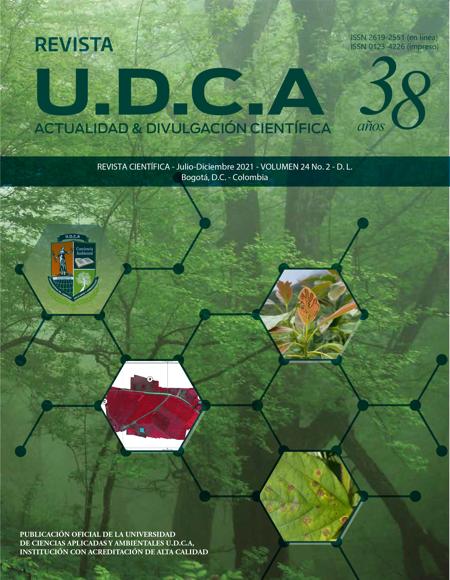Efectos de espaciamientos sobre el crecimiento y rendimiento del fríjol caupí cultivar Caupicor 50
Effects of spacings on the growth and yield of cowpea beans cultivar Caupicor 50
Contenido principal del artículo
Resumen
El fríjol caupí es una leguminosa importante en la región Caribe de Colombia, por su contribución a la dieta de sus pobladores y por ser una alternativa de ingresos para pequeños productores; sin embargo, los rendimientos obtenidos no superan los 600 kg ha-1, debido al desconocimiento del efecto de las prácticas culturales en la especie, como en los diversos cultivares. El objetivo del estudio fue evaluar el efecto de diferentes espaciamientos e hidrogel sobre características vegetativas y reproductivas del fríjol caupí cultivar Caupicor 50, en el departamento de Sucre, del Caribe colombiano. Se utilizó el diseño experimental parcelas sub-subdivididas, con tres repeticiones (bloques). Se combinaron dos distancias entre hileras: 60 y 80 cm en la parcela principal, tres distancias entre plantas: 20, 30 y 40 cm en la subparcela e hidrogel: 0 y 5 g/planta en la sub-subparcela. Las variables evaluadas fueron: altura de planta, área foliar, índice de área foliar, tasa de crecimiento del cultivo, número de vainas/planta, longitud de vaina, número de semillas/vaina, peso de cien semillas y rendimiento de semillas/ha. El mayor rendimiento, se estimó con 20 cm entre plantas y 60 cm entre hileras (83.333 plantas ha-1), con un rendimiento de 2.027 kg ha-1, asociado a mayor área foliar, índice de área foliar y tasa de crecimiento del cultivo y, a menor número de vainas por planta, longitud de vaina y peso de cien semillas.
Palabras clave:
Descargas
Datos de publicación
Perfil evaluadores/as N/D
Declaraciones de autoría
- Sociedad académica
- Universidad de Ciencias Aplicadas UDCA
- Editorial
- Universidad de Ciencias Aplicadas y Ambientales U.D.C.A
Detalles del artículo
Referencias (VER)
ALVES BASTOS, E.A.; DO NASCIMENTO, S.P.; DA SILVA, E.M.; FREIRE FILHO, F.F.; GOMIDE, R.L. 2011. Identification of cowpea genotypes for drought tolerance. Revista Ciência Agronômica (Brasil). 42(1):100-107.
https://doi.org/10.1590/S1806-66902011000100013
ALVES BASTOS, E.A.; MOREIRA RAMOS, H.M.; SOARES DE ANDRADE JÚNIOR, A.; NUNES DO NASCIMENTO, F.; CARDOSO, M.J. 2012. Parâmetros fisiológicos e produtividade de grãos verdes do feijão-caupi sob déficit hídrico. Water Resources and Irrigation Management (Brasil). 1(1):31-37.
APÁEZ BARRIOS, P.; ESCALANTE ESTRADA, J.A.S.; SOSA MONTES, E.; APÁEZ BARIOS, M.; RODRÍGUEZ GONZÁLEZ, M.T.; RAYA MONTAÑO, Y.A. 2016. Producción y calidad nutrimental de vaina del frijol chino, Vigna unguiculata (L.) Walp, en función de arreglo topológico y tipo de fertilización. Rev. FCA UNCUYO. (Argentina). 48(2):31-42.
ARAMÉNDIZ-TATIS, H.; CARDONA-AYALA, C.; JARMA, A.; COMBATT, E.; JARABA, J.; MERCADO, T.; ESPITIA-CAMACHO, M.; DE PAULA, C.; PASTRANA, Y.; HERNÁNDEZ, J. 2019. Manejo agronómico del fríjol caupí en el Caribe colombiano. Universidad de Córdoba. 22p.
BARRERA, J.L.; CARTAGENA, J.R.; NANCLARES, O. 2021. Influence of high density planting and spatial arrangement on growth and development in Musa AAA Simmonds. Rev. U.D.C.A Act. & Div. Cient. (Colombia). 24(1):e1312.
https://doi.org/10.31910/rudca.v24.n1.2021.1312
CARDOSO, M.J.; DE BRITO MELO, F.; QUEIROZ RIBEIRO, V. 2018. Population density on cowpea cultivars with different growth habits in the matopiba region. Rev. Caatinga. (Brasil). 31(1):235-239.
http://dx.doi.org/10.1590/1983-21252018v31n127rc
COSTA JUNIOR, M.J.N.; ALVES BASTOS, E.; CARDOSO, M.J.; ANDRADE JUNIOR, A. 2017. Agronomic performance of the cowpea under different irrigation depths and row spacing. Rev. Ciência Agronômica. (Brasil). 48(5 Especial):774-782.
http://dx.doi.org/10.5935/1806-6690.20170090
DA CAMARA, F.T.; DUARTE MOTA, A.M.; DE ARAÚJO NICOLAU, F.E.; ALVES PINTO, A.; FRANCIELE DA SILVA, J.M. 2018. Produtividade de feijão caupi crioulo em função do espaçamento entre linhas e número de plantas por cova. Revista de Agricultura Neotropical. (Brasil). 5(2):19-24.
https://doi.org/10.32404/rean.v5i2.2282
DE CARVALHO BEZERRA, A.A.; ALVES FERNANDES TÁVORA, F.J.; FREIRE FILHO, F.R.; QUEIROZ RIBEIRO, V. 2009. Características de dossel e de rendimento em feijão‑caupi ereto em diferentes densidades populacionais. Pesquisa Agropecuária Brasileira (Brasil). 44(10):1239-1245.
https://doi.org/10.1590/S0100-204X2009001000005
DE CARVALHO BEZERRA, A.A.; CABRAL DAS NEVES, A.; DE MOURA ROCHA, M.; RODRIGUES DE BRITO, L.C. 2017. Morpho-physiological and productive biometry in semi-erect cultivars of the cowpea under different plant population. Rev. Ciência Agronômica (Brasil). 48(4):625-630.
http://dx.doi.org/10.5935/1806-6690.20170072
DE SOUSA MENDES, R.M.; ALVES FERNADES TÁVORA, F.J.; NUNES DE PINHO, J.L.; BOSCO PITOMBEIRA, J. 2005. Alterações na relação fonte-dreno em feijão-de corda submetido a diferentes densidades de plantas. Revista Ciência Agronômica (Brasil). 36(1):82-90.
DE SOUSA MONTEIRO, M.M.; ALVES BASTOS, E.; CARDOSO, M.J.; SOARES DE ANDRADE JÚNIOR, A.; QUEIROZ RIBEIRO, V. 2017. Effect of water regimes and plant densities on cowpea production. Pesq. Agropec. Trop. (Brasil). 47(4):432-439.
https://doi.org/10.1590/1983-40632017v4747908
EL NAIM, A.M.; JABERELDAR, A.A. 2010. Effect of plant density and cultivar on growth and yield of cowpea (Vigna unguiculata L. Walp). Australian J. Basic and Applied Sciences. (Australia). 4(8):3148-3153.
GONÇALVES, I.S.; DA SILVA, R.R.; DE OLIVEIRA, G.M.; PINTO SANTIAGO, E.J.; ALVES DE OLIVEIRA, V.E. 2017. Características fisiológicas e componentes de produção de feijão caupi sob diferentes lâminas de irrigação. J. Environmental Analysis and Progress (Brasil). 2(3):320-329.
http://dx.doi.org/10.24221/jeap.2.3.2017.1456.320-329
HISSENE, H.M.; VADEZ, V.; CLAVIJO MICHELANGELI, J.; HALILOU, O.; NDOYE, I.; SOLTANI, A.; SINCLAIR, T. 2016. Quantifying Leaf Area Development Parameters for Cowpea [Vigna unguiculata (L.) Walpers]. Crop Science (USA). 56(6):3209-3217.
https://doi.org/10.2135/cropsci2016.02.0132
HUYNH, B.L.; CLOSE, T.J.; ROBERTS, P.A.; HU, Z.; WANAMAKER, S.; LUCAS, M.R.; CHIULELE, R.; CISSÉ, N.; ANTONIO, D.; HEARNE, S.; FATOKUN, C.; DIOP, N.N.; EHLERS, J.D. 2013. Gene pools and the genetic architecture of domesticated cowpea. The plant genome (USA). 6(3):1-8.
https://doi.org/10.3835/plantgenome2013.03.0005
INSTITUTO DE HIDROLOGÍA, METEOROLOGÍA Y ESTUDIOS AMBIENTALES, IDEAM. 2014. Tiempo y Clima. Promedios Climatológicos 1981-2010. Disponible desde Internet en http://www.ideam.gov.co/web/tiempo-y-clima/clima (con acceso el 18/06/2020).
JAKUSKO, B.B.; ANASUNDA, U.I.; MUSTAPHA, A.B. 2013. Effect of inter-row spacing on some selected Cowpea (Vigna unguiculata (L) Walp) varieties in Yola, Adamawa State, Nigeria. IOSR J Agric Vet Sci. 2(1):30-35.
https://doi.org/10.9790/2380-0233035
JIMÉNEZ GALINDO, J.C.; ACOSTA GALLEGOS, J.A. 2013. Efecto de la densidad a simple y doble hilera en el rendimiento de frijol de temporal en Chihuahua, México. Rev. Mexicana de Ciencias Agrícolas (México). 4(3):393-407.
http://dx.doi.org/10.29312/remexca.v4i3.1201
KAMARA, A.Y.; TOFA, A.I.; KYEI-BOAHEN, S.; SOLOMON, R.; AJEIGBE, H.A.; KAMAI, N. 2018. Effects of plant density on the performance of cowpea in Nigerian savannas. Experimental Agriculture (Inglaterra). 54(1):120-132.
https://doi.org/10.1017/S0014479716000715
KURUMA, R.W.; SHEUNDA, P.; KAHWAGA, C.M. 2019. Yield stability and farmer preference of cowpea (Vigna unguiculata) lines in semi-arid eastern Kenya. Afrika Focus (Bélgica). 32(2):65-82.
https://doi.org/10.21825/af.v32i2.15768
MAKOI, J.H.J.R.; CHIMPHANGO, S.B.M.; DAKORA, F.D. 2010. Photosynthesis, water-use efficiency and δ13C of five cowpea genotypes grown in mixed culture and at different densities with sorghum. Photosynthetica. 48(1):143-155.
http://dx.doi.org/10.1007/s11099-010-0019-2
PEDROZA-SANDOVAL, A.; YÁÑEZ-CHÁVEZ, L.G.; SÁNCHEZ-COHEN, I.; SAMANIEGO-GAXIOLA, J.A. 2015. Efecto del hidrogel y vermicomposta en la producción de maíz. Revista fitotecnia mexicana (México). 38(4):375-381.
https://doi.org/10.35196/rfm.2015.4.375
SOARES DE MELO, A.S.; FERREIRA DA SILVA, A.R.; FILGUEIRAS DUTRA, A.; FILGUEIRAS DUTRA, W.; DA SILVA SÁ, F.V.; DE MOURA ROCHA, M. 2018. Crescimento e pigmentos cloroplastídicos de genótipos de feijão vigna sob déficit hídrico. Rev. Brasileira de Agricultura Irrigada. 12(3):2579-2591.
https://doi.org/10.7127/rbai.v12n300698
SOUZA LOPES, M.B.; DE OLIVEIRA TAVARES, T.C.; ALVES VELOSO, D.; DA SILVA, N.C.; RIBEIRO FIDELIS, R. 2017. Cowpea bean production under water stress using hydrogels. Pesq. Agropec. Trop. (Brasil). 47(1):87-92.
https://doi.org/10.1590/1983-40632016v4743398
SOUZA PEREIRA, J.S.; OLSZEVSKI, N.; CRUZ DA SILVA, J. 2018. Retenção de água e desenvolvimento do feijão caupi em função do uso de polímero hidrorretentor no solo. Revista Engenharia na Agricultura (Brasil). 26(6):582-591.
https://doi.org/10.13083/reveng.v26i6.857
WUBETU, A. 2018. Effects of Intra and Inter-Row Spacing on Yield and Yield Components of Mung Bean (Vigna radiate L.). J. Biology, Agriculture and Healthcare (India). 8(12):1-9.







